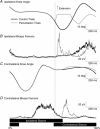Interlimb communication to the knee flexors during walking in humans
- PMID: 23918771
- PMCID: PMC3800463
- DOI: 10.1113/jphysiol.2013.257949
Interlimb communication to the knee flexors during walking in humans
Abstract
A strong coordination between the two legs is important for maintaining a symmetric gait pattern and adapting to changes in the external environment. In humans as well as animals, receptors arising from the quadriceps muscle group influence the activation of ipsilateral muscles. Moreover, strong contralateral spinal connections arising from quadriceps and hamstring afferents have been shown in animal models. Therefore, the aims of the present study were to assess if such connections also exist in humans and to elucidate on the possible pathways. Contralateral reflex responses were investigated in the right leg following unexpected unilateral knee joint rotations during locomotion in either the flexion or extension direction. Strong reflex responses in the contralateral biceps femoris (cBF) muscle with a mean onset latency of 76 ± 6 ms were evoked only from ipsilateral knee extension joint rotations in the late stance phase. To investigate the contribution of a transcortical pathway to this response, transcranial magnetic and electrical stimulation were applied. Motor evoked potentials elicited by transcranial magnetic stimulation, but not transcranial electrical stimulation, were facilitated when elicited at the time of the cBF response to a greater extent than the algebraic sum of the cBF reflex and motor evoked potentials elicited separately, indicating that a transcortical pathway probably contributes to this interlimb reflex. The cBF reflex response may therefore be integrated with other sensory input, allowing for responses that are more flexible. We hypothesize that the cBF reflex response may be a preparation of the contralateral leg for early load bearing, slowing the forward progression of the body to maintain dynamic equilibrium during walking.
Figures




References
-
- Andersen JB, Sinkjær T. Mobile ankle and knee perturbator. IEEE Trans Biomed Eng. 2003;50:1208–1211. - PubMed
-
- Bachmann V, Müller R, van Hedel HJA, Dietz V. Vertical perturbations of human gait: Organisation and adaptation of leg muscle responses. Exp Brain Res. 2008;186:123–130. - PubMed
-
- Bayoumi A, Ashby P. Projections of group Ia afferents to motoneurons of thigh muscles in man. Exp Brain Res. 1989;76:223–228. - PubMed
Publication types
MeSH terms
LinkOut - more resources
Full Text Sources
Other Literature Sources

